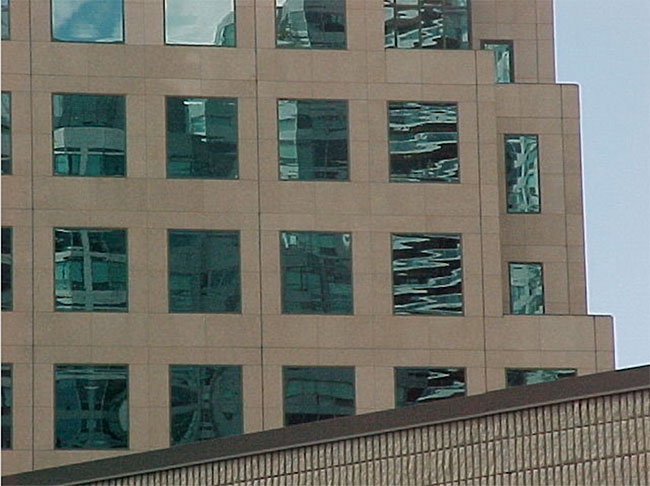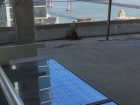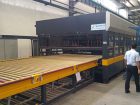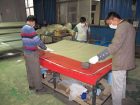
Features
Fabrication
Processing & productivity
The three Qs: Implement a complete quality process to avoid fade in overseas operations
Attention to each aspect of quality is important, especially when buying offshore.
March 19, 2018 By George Torok and Yvon Chiasson Morrison Hershfield
 Distortion of reflected images is visible in this heat-treated glass. Improved tempering technology is making roller wave distortion less of a concern for sophisticated manufacturers. Photo credit: Torok/Chiasson
Distortion of reflected images is visible in this heat-treated glass. Improved tempering technology is making roller wave distortion less of a concern for sophisticated manufacturers. Photo credit: Torok/ChiassonMeeting the budget for construction of a building can be a challenge, especially when a proposed design may be aspirational rather than strictly practical. Public and private sector owners, construction managers, general contractors, sub-contractors, fenestration system and component suppliers have, for many years, looked for cost savings through continental and increasingly, global procurement (i.e. outside North America and overseas).
Sourcing product from afar has its opportunities and rewards, and associated risks. A QA, QC and QF process is vital to achieving expected quality construction.
What is QA? QC? And especially QF? The meaning of the first two acronyms should not be unfamiliar – Quality Assurance and Quality Control. Quality Assurance is the plan to achieve the desired quality. Quality Control is how that will be done – the nuts and bolts, test methods, frequency of test methods, pass/fail criteria, responses to failure to correct what’s been made incorrectly and then preventing recurrence of the same mistake, and documenting all of it. QF means Quality Fade, or the drift in quality that may occur during manufacture or installation of a building component or assembly. Quality Fade may occur because of ‘loopholes’ in building code requirements, referenced standards, familiarity with industry practices (North American practices different than overseas practices), and/or lack of accountability/transparency from remote manufacturers (input from third part review of QA/QC not considered, and not followed/implemented in a regimented fashion). A QA plan and QC procedures must recognize the potential for QF and include ways and means to prevent it, to remediate incorrectly made product, and to rectify the required steps in the QA/QC to prevent recurrence, and mitigate future risks.
There are surprising omissions within and between building codes, referenced standards (ASTM, ANSI, CSA, CGSB, etc.), and industry practices (IGMA, GANA, SGCC, AAMA, etc.) that may result in less than desirable quality outcomes. Have you ever heard a supplier state that a building code does not include, or it is not typical industry practice to meet, a certain requirement of the project specifications so that requirement will not be met? It wasn’t included in the price because it is not normal to do so? With remote, off-shore procurement, there may also be conflicts between codes, standards and industry practices of the country of origin and those of the destination country that are not recognized by either party . The design and construction team should be aware of potential omissions in codes, standards and industry practices and address them as early as possible to avoid surprises too late in the construction process to make changes. The project schedule is king and often cannot be swayed to correct unexpected quality issues.
When should QA/QC/QF begin? Ideally, in the construction document preparation phase, definitely before selecting the remote suppliers. What issues are important to the owner, the designers, the constructor? In speculative construction, the end user does not have a seat at the table so those present must not forget those who are missing. Reach out to trusted manufacturers and constructors from past work in which good quality success was achieved, even though for them, early in the design development or construction documentation phases, there are no guarantees they would secure a portion of the work to compensate for time spent. Engage the services of a façade consultant with experience in remote procurement for their perspective on recommended QA/QC/QF traps and solutions.
Consider remote procurement of insulating glass units to be included in, say, a curtain wall for a commercial or residential tower. Performance parameters can be established with the assistance of a building performance analytics consultant to meet locally applicable energy code requirements (OBC SB-10 in Ontario, NECB in other provinces, etc.) including solar heat gain coefficient, winter U-factor and perhaps condensation resistance. Products considered during design must meet the required performance characteristics but be careful, performance must be calculated to North American and sometimes, Canadian norms. European U-value is not the same as a North American U-factor. USA Condensation Resistance Factor (CRF) is not the same as a Canadian Temperature Index value.
Other aspects of glass and façade appearance and performance to be considered include colour, exterior reflectance, visible light transmission/daylighting contribution. It is not uncommon for combinations of thermal performance and aesthetic requirements to give rise to thermal stress and consequently, a need for glass to be heat treated. Heat treatment may also be necessary to address wind loads and safety for building occupants and passers-by at grade. Unintended consequences of heat treatment are distortion of reflected images (roller wave distortion, photo 1) and colour shifting of transmitted light (anisotropy, sometimes also referred to as quench marks or strain pattern, photo 2). Neither is limited by Canadian building codes and referenced standards for heat treated glass (ASTM C1048, referenced through CGSB-12.1). The good news is manufacturers of tempering equipment are constantly striving to reduce roller wave distortion so fabricators with late model equipment should be able to limit distortion of reflected images. The not so good news is anisotropy is generally regarded by the glazing industry as a fact of life and ignored, although a few manufacturers of tempering furnaces have identified anisotropy as a growing concern and are developing furnaces and quench equipment to control the underlying causes.
How can these issues be addressed by a QA, QC and QF process? QA should identify the quality goals to achieve, the codes, standards and practice documents to be followed, and supplemental guidance/requirements to fill in omissions within and between them. Some quality aspects may be difficult to achieve, such as heat treated glass that is free of roller waves or anisotropy, so it may be necessary to consider alternatives such as using heat strengthened glass instead of tempered glass in the outboard pane of insulating glass units whenever possible (roller wave distortion is typically less in heat strengthened glass). The QC program needs to be designed to empower workers on the assembly line to set aside fabricated components that are demonstrably ‘out of spec’ without being disciplined.
QC should set out reasonable and achievable goals to achieve or limits to undesirable outcomes, and recording results. For example, specifying maximum allowable wave peak-to-valley dimensions for roller wave distortion of heat treated glass. Other aspects of heat treated glass manufacture could also be defined and limited, such as maximum allowable edge lift and overall bow values and surface compressive stress. Anisotropy would be harder to define and limit since it is not addressed by codes, standards or practice documents. It may be possible to establish a qualitative metric, for example preparation of full sized mock-ups to define an acceptable range of colour variation which then serve as a guide for assessing subsequent production. Recently, on-line scanners have been developed to assess anisotropy during manufacture so once an maximum acceptable limit is defined, heat strengthened glass exiting from the quench can be checked, accepted or rejected. Feedback from such systems into numeric control for the furnace allows adjustments to be made to subsequent production to be within accepted limits.
This brings us to QF, the ‘boots on the ground’ process to make sure QC is being properly executed and enforced to achieve QA goals. An implicit assumption in codes, standards and practice documents is self-regulation by manufacturers. North American Industry associations such as IGCC, IGMA and SGCC provide, for members, auditing processes to help manufacturers consistent fabricate products well, consistent with compliance tested samples, but those services are not project specific. Like any human endeavor, there are top-of-the-line manufacturers and those less so; price is often a good indicator of quality locally but when procuring globally from countries with different standards and cost of living, more or less access to natural resources, etc., it may be difficult to assess if a submitted price is fair for the effort anticipated. Will the quality of the manufactured product be as good as from a local supplier (Photo 3)? Or better (Photo 4)? A QA/QC document may seem right but if not actually put into practice, the QA plan and QC ways and means are meaningless.
Whether local or remote/global supply, we recommend adding a project-specific QF process. This involves critical review of each manufacturer’s QA plan and QC ways and means to ensure it clearly sets out the goals to achieve and appropriate and necessary test methods, outcome limits and sampling frequency, revision of the QA and QC document until it is suitable, preparation of mock-ups when needed to establish acceptable limits, followed by visits to manufacturing facilities to verify QA and QC are being followed, and following through with corrective action if QF is detected. It is better to nip a problem in the bud than to deal with it later, causing delays in construction or unacceptable quality in the finished product.
At the recent FenCon18 conference in Winnipeg, Ian Marshall of Canadian Manufacturers and Exporters held workshops on applying Continuous Improvement (CI) and Lean manufacturing concepts in a fenestration fabrication environment. A lot of the discussion was about improving manufacturing efficiency, but the Lean process also integrates quality to a high degree and makes better quality possible by making time and resources available to dedicate to it. And, of course, the whole idea of Continuous Improvement is to get continuously better at everything you do, all the time.
QA is improved through CI processes because the fundamental concept of CI is to make a plan and upgrade it. Rather than leave things to chance or just let processes evolve as they may, CI demands you evaluate everything you do very carefully and ask whether it could be done better. It’s inevitable that this approach will improve quality, and you’ll probably look askance at any supplier that isn’t doing this.
CI and Lean have even more application on the QC side, since fixing processes down to the smallest detail is what these programs are all about. In Marshall’s workshop, which involved window manufacturers building airplanes with Lego, it was easy to see how a poorly thought-out process, especially under time pressure, led to quality issues. And conversely how a good process, with QC integrated at every step, could lead to predictable quality.
For brevity, we’ve discussed only a few aspects of glass fabrication. There are other performance and quality concerns to consider in the manufacture and assembly of fenestration systems and other factory assembly enclosure systems, including a myriad of on-site assembly procedures not covered in this article. Building enclosure systems are increasing in complexity and as performance requirements become more stringent, the tolerance for failure becomes lower. But it has to be on the QF end that CI really shines. Quality fade comes from a lack of process, or a process that is abandoned under time and resource pressure. CI and Lean programs are specifically designed to address and mitigate these issues. Looking for suppliers and partners that embrace these concepts could be one way to escape the QF problems that can plague offshore outsourcing.
About the authors
George Torok is a fenestration specialist and a member of Morrison Hershfield’s Building Performance Analytics Team, based in Ottawa, Ont. George has over 30 years’ experience in building enclosure design, construction, performance assessment, failure investigation and rehabilitation for public and private sector buildings of all types across North America. George works with building owners and design teams to achieve balanced, practical and innovative solutions, and provides peer support and mentoring within MH. His focus is fenestration technology, including low-rise residential windows, doors and skylights, high-rise residential window wall, commercial curtainwall and custom, one-of-a-kind glazed enclosures architectural structures. He may be reached at gtorok@morrisonhershfield.com.
Yvon Chiasson is a senior building science specialist and a member of Morrison Hershfield’s Building Performance Analystics Team, based in Burlington, Ont. Yvon has over 21 years of consulting experience and 13 years of R&D and technical sales experience with a major global provider of sealants. Yvon has managed projects for various commercial, high-rise, and institutional buildings, both private and public sector clients, and provided technical support to clients in North America, Europe and the Middle East. He may be reached at ychiasson@morrisonhershfield.com.
For more information
morrisonhershfield.com
•
Print this page




Leave a Reply